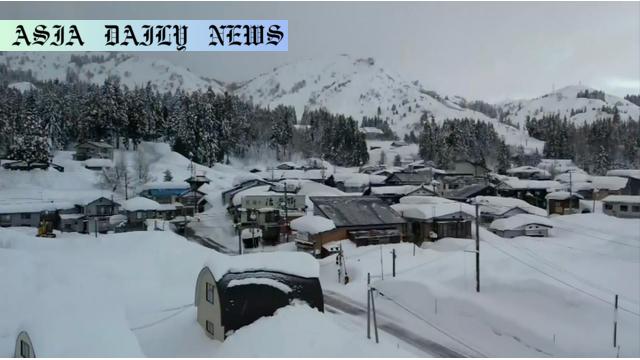Heavy Snow: The strongest cold air mass of the season brought unprecedented snow to Japan’s central and western regions.
Heavy snow blankets Japan, affecting both mountainous and flat regions.
Niigata sees 3 meters of snow while 70 cm more is expected in Tohoku.
Traffic disruptions, strong winds, and power outages predicted.
Weather officials warn of snowstorms, fallen trees, and snow slides.

Unusual Snowfall Blankets Japan’s Coastal Regions
The strongest cold wave of the season has brought unprecedented snowfall to areas along Japan’s Sea of Japan coast, including regions typically unaccustomed to heavy snow. The Japan Meteorological Agency has reported significant snow accumulation in central and western Japan, with snow spreading even into flat regions where such weather is a rarity. This unprecedented weather pattern began Friday night and has intensified, causing widespread disruptions and raising safety concerns across the regions affected.
Regional Snow Totals Exceed Seasonal Averages
Several towns saw significant snowfall over the course of a single day. In Kusatsu Town, Gunma Prefecture, 21 cm of snow accumulated in just six hours; Daisen Town in Tottori recorded 18 cm, and Nikko City in Tochigi tracked 17 cm. Noteworthy was the snow buildup in Niigata Prefecture and the Hokuriku region, which exceeded seasonal averages. The unprecedented accumulation in Uonuma City in Niigata and Tadami Town in Fukushima reached as much as 3 meters by Saturday afternoon. Snow clouds also extended to rare areas such as Nagoya and Kyoto, adding to the sense of urgency around the country.
Forecast and Upcoming Concerns
Heavy snowfall is expected to persist through Sunday, especially in areas along the Sea of Japan and other mountainous regions. Projections by the Japan Meteorological Agency estimate up to 70 cm in Tohoku’s mountainous areas, 60 cm in Niigata Prefecture, and 50 cm in parts of Gifu and the Kinki region. Even areas unaccustomed to snowfall, such as the flat Tokai and Kinki regions, are expected to see larger accumulations, prompting further caution as the days progress.
Nationwide Impact and Danger Advisories
With this worsening weather, authorities have issued nationwide advisories urging people to prepare for traffic disruptions, snowstorms, and dangerous driving conditions in snowy and icy regions. Power outages, fallen trees, snow slides, and strong winds are anticipated across Japan. Concerns about high waves and aggravated sea conditions have also emerged, with gusty winds and lightning strikes adding further risks.
A Historical Perspective on the Current Cold Wave
The scale and intensity of the current snowfall reflect how climate variability can introduce extreme weather patterns with limited warning. While snowfall isn’t uncommon in Niigata Prefecture or the Tohoku region, the wide geographical spread covering flat areas in cities such as Nagoya and Kyoto raises questions about preparation and mitigation in urban centers traditionally untouched by such phenomena.
Conclusion: The Need for Vigilance
Japan’s harsh winter reality this season highlights the critical need for constant weather monitoring and adaptive planning. Weather officials emphasize precautionary measures to ensure public safety, from staying indoors where possible to avoiding unnecessary travel. As heavy snow continues to blanket the country, vigilance remains the highest priority for individuals and authorities alike.



Commentary
Understanding the Unprecedented Snowfall
The recent heavy snowfalls across Japan have been a vivid reminder of nature’s unpredictability. For regions like Niigata, such weather is not unprecedented; however, the spread of snowfall into areas like Nagoya and Kyoto underscores the unique intensity of this event. This deviation from normal weather patterns demonstrates how climate variability can surprise even the most prepared institutions.
The Impacts on Daily Life
For residents in affected regions, the challenges are immense. Snow accumulation disrupts transportation, restricts movement, and poses threats to infrastructure. Communities rely on winter preparedness; however, when snow extends to typically unaffected regions, even these preparations may fall short. Observing cities like Kyoto covered in snow provides an unusual and striking image of this winter’s severity.
Resilience in the Face of Adversity
Despite the disruptions, one cannot overlook the resilience shown by communities and authorities facing this extreme winter. From issuing widespread advisories to mobilizing resources for snow removal, efforts are underway to minimize risks. It is also a call to action for long-term solutions that combine modern technology with traditional knowledge to counter the effects of severe weather and potential climate variability.
A Lesson for Future Preparedness
This weather event should serve as a lesson for nations around the world. Extreme conditions can arise unexpectedly, and investing in preparedness remains paramount. Japan’s comprehensive warning system is exemplary, but events like this highlight the need for further innovation and awareness. As communities dig themselves out of an extraordinary amount of snow, they also contribute to a collective understanding of resilience and adaptation.